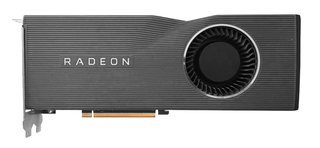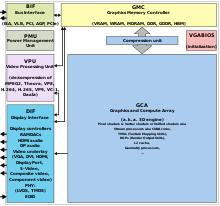
Advanced Micro Devices, Inc. (AMD) is an American multinational corporation and semiconductor company based in Santa Clara, California, that develops computer processors and related technologies for business and consumer markets.

Radeon is a brand of computer products, including graphics processing units, random-access memory, RAM disk software, and solid-state drives, produced by Radeon Technologies Group, a division of AMD. The brand was launched in 2000 by ATI Technologies, which was acquired by AMD in 2006 for US$5.4 billion.
AMD PowerPlay is the brand name for a set of technologies for the reduction of the energy consumption implemented in several of AMD's graphics processing units and APUs supported by their proprietary graphics device driver "Catalyst". AMD PowerPlay is also implemented into ATI/AMD chipsets which integrated graphics and into AMD's Imageon handheld chipset, that was sold to Qualcomm in 2008.

The Radeon HD 7000 series, codenamed "Southern Islands", is a family of GPUs developed by AMD, and manufactured on TSMC's 28 nm process.
Graphics Core Next (GCN) is the codename for a series of microarchitectures and an instruction set architecture that were developed by AMD for its GPUs as the successor to its TeraScale microarchitecture. The first product featuring GCN was launched on January 9, 2012.

The Radeon HD 8000 series is a family of computer GPUs developed by AMD. AMD was initially rumored to release the family in the second quarter of 2013, with the cards manufactured on a 28 nm process and making use of the improved Graphics Core Next architecture. However the 8000 series turned out to be an OEM rebadge of the 7000 series.
Video Code Engine is AMD's video encoding application-specific integrated circuit implementing the video codec H.264/MPEG-4 AVC. Since 2012 it was integrated into all of their GPUs and APUs except Oland.
The Radeon 400 series is a series of graphics processors developed by AMD. These cards were the first to feature the Polaris GPUs, using the new 14 nm FinFET manufacturing process, developed by Samsung Electronics and licensed to GlobalFoundries. The Polaris family initially included two new chips in the Graphics Core Next (GCN) family. Polaris implements the 4th generation of the Graphics Core Next instruction set, and shares commonalities with the previous GCN microarchitectures.

Zen 2 is a computer processor microarchitecture by AMD. It is the successor of AMD's Zen and Zen+ microarchitectures, and is fabricated on the 7 nm MOSFET node from TSMC. The microarchitecture powers the third generation of Ryzen processors, known as Ryzen 3000 for the mainstream desktop chips, Ryzen 4000U/H and Ryzen 5000U for mobile applications, as Threadripper 3000 for high-end desktop systems, and as Ryzen 4000G for accelerated processing units (APUs). The Ryzen 3000 series CPUs were released on 7 July 2019, while the Zen 2-based Epyc server CPUs were released on 7 August 2019. An additional chip, the Ryzen 9 3950X, was released in November 2019.
Zen+ is the codename for a computer processor microarchitecture by AMD. It is the successor to the first gen Zen microarchitecture, and was first released in April 2018, powering the second generation of Ryzen processors, known as Ryzen 2000 for mainstream desktop systems, Threadripper 2000 for high-end desktop setups and Ryzen 3000G for accelerated processing units (APUs).
The Radeon RX Vega series is a series of graphics processors developed by AMD. These GPUs use the Graphics Core Next (GCN) 5th generation architecture, codenamed Vega, and are manufactured on 14 nm FinFET technology, developed by Samsung Electronics and licensed to GlobalFoundries. The series consists of desktop graphics cards and APUs aimed at desktops, mobile devices, and embedded applications.

The Radeon RX 5000 series is a series of graphics processors developed by AMD, based on their RDNA architecture. The series is targeting the mainstream mid to high-end segment and is the successor to the Radeon RX Vega series. The launch occurred on July 7, 2019. It is manufactured using TSMC's 7 nm FinFET semiconductor fabrication process.

RDNA 2 is a GPU microarchitecture designed by AMD, released with the Radeon RX 6000 series on November 18, 2020. Alongside powering the RX 6000 series, RDNA 2 is also featured in the SoCs designed by AMD for the PlayStation 5, Xbox Series X/S, and Steam Deck consoles.

Zen 3 is the codename for a CPU microarchitecture by AMD, released on November 5, 2020. It is the successor to Zen 2 and uses TSMC's 7 nm process for the chiplets and GlobalFoundries's 14 nm process for the I/O die on the server chips and 12 nm for desktop chips. Zen 3 powers Ryzen 5000 mainstream desktop processors and Epyc server processors. Zen 3 is supported on motherboards with 500 series chipsets; 400 series boards also saw support on select B450 / X470 motherboards with certain BIOSes. Zen 3 is the last microarchitecture before AMD switched to DDR5 memory and new sockets, which are AM5 for the desktop "Ryzen" chips alongside SP5 and SP6 for the EPYC server platform and sTRX8. According to AMD, Zen 3 has a 19% higher instructions per cycle (IPC) on average than Zen 2.

The Radeon RX 6000 series is a series of graphics processing units developed by AMD, based on their RDNA 2 architecture. It was announced on October 28, 2020 and is the successor to the Radeon RX 5000 series. It consists of the entry-level RX 6400, mid-range RX 6500 XT, high-end RX 6600, RX 6600 XT, RX 6650 XT, RX 6700, RX 6700 XT, upper high-end RX 6750 XT, RX 6800, RX 6800 XT, and enthusiast RX 6900 XT and RX 6950 XT for desktop computers; and the RX 6600M, RX 6700M, and RX 6800M for laptops. A sub-series for mobile, Radeon RX 6000S, was announced in CES 2022, targeting thin and light laptop designs.

RDNA 3 is a GPU microarchitecture designed by AMD, released with the Radeon RX 7000 series on December 13, 2022. Alongside powering the RX 7000 series, RDNA 3 is also featured in the SoCs designed by AMD for the Asus ROG Ally and Lenovo Legion Go consoles.

The Radeon RX 7000 series is a series of graphics processing units developed by AMD, based on their RDNA 3 architecture. It was announced on November 3, 2022 and is the successor to the Radeon RX 6000 series. Currently AMD has announced six graphics cards of the 7000 series: RX 7600, RX 7600 XT, RX 7700 XT, RX 7800 XT, RX 7900 XT and RX 7900 XTX. AMD officially launched the RX 7900 XT and RX 7900 XTX on December 13, 2022. AMD released the RX 7600 on May 25, 2023. AMD released their last two graphics processing units of the RDNA 3 family on September 6, 2023; the 7700 XT and the 7800 XT. As of January 2024, they have also released the RX 7600 XT.















